Lama Information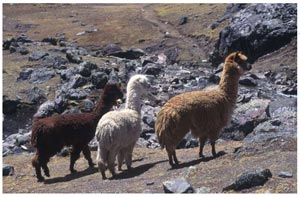
General Information
South American Camelids
Lama is the term used to refer to South American camelids, including llamas, alpacas, guanacos and vicunas. Although primarily used for show and recreation in North America, llamas make great companion pets. These animals differ from true ruminants in many ways, and individuals need a good understanding of the llama to work with these animals more effectively.
There are 4 species of camelids native to the South American continent. Llamas (Lama glama) and Alpacas (Lama pacos) are domesticated species. The Guanaco (Lama guanicoe) and the Vicuna (Vicugna vicugna) are wild species. Llamas come in many colors and wool types; the wool of all four species can be spun but the wool of the llama is the least desirable. The llama is a domestic animal, primarily developed as a beast of burden. The alpaca is also a domestic animal but guanacos and vicunas are not domesticated and exportation of both species has been tightly controlled until recently. Vicunas are currently on the endangered list due to heavy hunting for their fine fiber, which is worth more on the world market than silk.
Ruminants and camelids are all in the Order Artiodactyla (even-toed hoof stock). Camelids belong to the Suborder Tylopoda. Ruminants belong to the Suborder Ruminantia, which includes cattle, deer, sheep, goats, antelope and gazelles. How do you differentiate between a llama and an alpaca? Size (alpacas are smaller and finer featured); cost (alpacas were once tremendously overpriced); quality, thickness, and crimp of wool; and shape and size of ears (llamas wear bananas!).
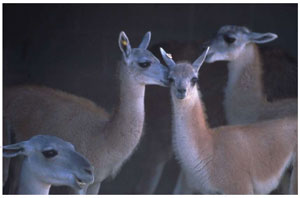 Curved ears were once very popular. Now straight ears are well accepted. Attempts are being made to continuously improve the wool quality in llamas. Most American llamas are related to a small band of less than 50 that were imported in the 20s or 30s and may not have been of superior wool quality. Now that South American countries have relaxed restrictions on exportation of llamas to the US, Peruvian, Chilean, and Bolivian llamas are expensive and prestigious. These recent imports appear to be greatly improving the quality of American llama wool. Heavy wooled llamas are those that have wool on the ears and below the hocks. Crimped wool is highly desirable as it stretches well after it is woven and it spins well. Curved ears were once very popular. Now straight ears are well accepted. Attempts are being made to continuously improve the wool quality in llamas. Most American llamas are related to a small band of less than 50 that were imported in the 20s or 30s and may not have been of superior wool quality. Now that South American countries have relaxed restrictions on exportation of llamas to the US, Peruvian, Chilean, and Bolivian llamas are expensive and prestigious. These recent imports appear to be greatly improving the quality of American llama wool. Heavy wooled llamas are those that have wool on the ears and below the hocks. Crimped wool is highly desirable as it stretches well after it is woven and it spins well.
Llamas ingest forage, regurgitate and rechew (i.e. ruminate); however, they are not ruminants. The camelids possess a 3-compartmented stomach, easily remembered as C-1, C-2, C-3. To date there are approximately 120,000 llamas and about 10,000 alpacas in North America. When it comes to working with llamas, the slow and easy approach usually works best. If the animal's first experience with clinical personnel is positive, it will go a long way in acceptance for future treatments. Understanding the llama's body language and responses to procedures are key to success in handling them. A happy hum and a nose sniff are the ultimate signs of gratitude.
Coccidia Infect Camelids in North Carolina
The year of 2007 has been another very challenging year for llamas and alpacas here in North Carolina. The extremely mild winter has allowed coccidia to survive and attack camelids in our state with vengeance. This parasite can cause severe gastrointestinal damage which may result in anemia, slow weight loss, and eventually death if not properly treated.
This has been the first year that significant numbers of coccidia have been consistently detected in herds routinely monitored by this practice via fecal evaluations. Coccidia need about 30 days of constant extreme weather being either below 32 F or very severe drought with heat above 100 F for about 30 days to destroy them.
This has not been the case for this past winter or the current summer here in our region. My practice has seen one alpaca death resulting from coccidiosis this year. There are several drug available to successfully treat this disease. Owner are advised to consult you local veterinarian to have routine fecal evaluations performed to determine potential parasite problems. Your veterinarian can then provide you the best recommendation for treatment and prevention of future problems with these potentially lethal parasites.
Tapeworms in Camelids
Tapeworms are a common parasite that routinely infect llamas and alpacas. This highly preventable parasite does not normally cause major problems in these animals. However, in severe cases, tapeworms may become so abundant in number that they can cause blockage of the intestinal tract. This may result in death if left untreated. It is very beneficial to have annual fecal evaluations performed to determine if these or other parasites are present. This is the only way to determine if your deworming program is working effectively. Tapeworms can be effectively treated with a few different anthelmentics (dewormers). Some of these medications may cause severe reactions like abortion and possibly death in pregnant or severely debilitated animals. Consult your veterinarian to determine which product is safest to use for your situation.
Strongylosis in Camelids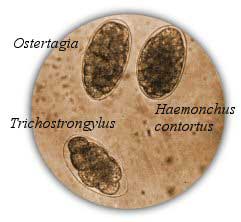
Strongyles can infect lamas and alpacas. It is seen most commonly in large herd with limited pasture space or in herds where llamas or alpacas are forced to graze with sheep and/or goats. Camelids are naturally clean animals that will typically designate a chosen area of a pasture or paddock for urination and defecation.
Sheep and goats do not discriminate over where they urinate and defecate. Their behavior make them very prone to contaminating valuable grazing area with parasite infested feces that may eventually cross over to other animals.
It is advisable to put camelids housed with these species on similar parasite management plans to effectively prevent problems in these herds. It is very important to regularly monitor parasites in these situations. There are several dewormer available to effectively kill strongyles. There is no single dewormer available that will kill all parasites that camelids get. Consult your veterinarian to determine the best plan to manage your herd.
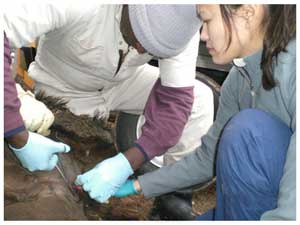 

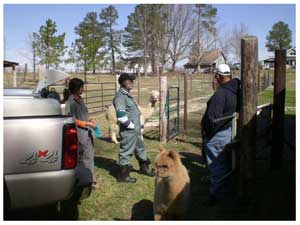
lama-doc@mymobilevet.com

|

